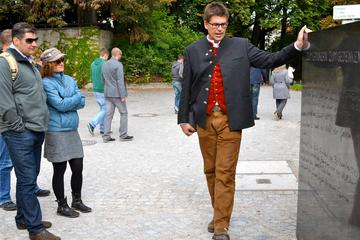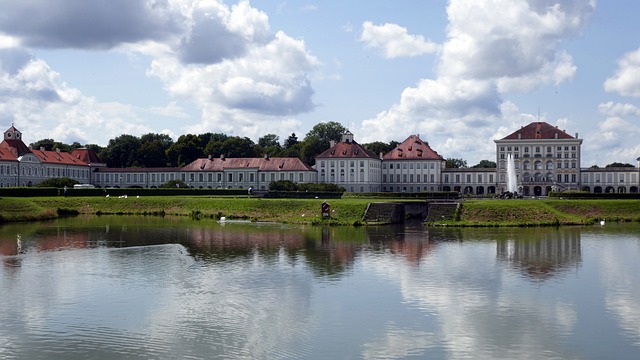
Munich is a vibrant German city rich in culture, history, and breathtaking scenery. Through the ages it has appealed to travelers from all walks of life, as it does to this day. But a city’s story can best be told through its most photographed places and moments in time.
Join us as we explore 5 Unforgettable moments in Munich captured through the lens of iconic travelers.
1. The Magic of Marienplatz at Sunset
This central square has been at the heart of Munich since the city was founded in 1158. During the Middle Ages, it hosted tournaments where medieval knights showed off their skills in front of enthusiastic crowds. But while those days are long gone, this iconic square still plays an important role in Munich life.
The square is filled with much to see and do, and especially photograph, but the Neues Rathaus (new town hall) deserves a special mention. Indeed, it is perhaps one of Munich’s most identifiable locations, gracing the front of travel postcards for years.
This impressive neo-Gothic structure with its turrets and statues attract tourists from across the world. Its magnificent architecture is especially beautiful at sunset, drawing crowds of tourists and travel photographers eager to capture the moment.
A hub of activity for locals and tourists alike, Marienpatz is also the site of Munich’s famous annual Christmas Market, known as Christkindlmarkt.
2. Exploring Munich’s Historical Side at the Dachau Memorial Site
While it is not in Munich itself, Dachau is nearby enough that most visitors to Munich include it in their itinerary.
A visit to the Dachau Concentration Camp Memorial is always an interesting yet sobering experience. The liberation of Dachau at the end of World War Two was extensively photographed. These black and white images can still be viewed today, an example of how photography educates others about history’s darkest moments.
For those fascinated by the history of World War Two, a Band of Brothers Tour is ideal. This tour company offers all-inclusive tours that explore the most pivotal moments of the war at European sites. Several tours are available, including one that starts in Munich.
3. Strolling Through the English Garden
The Englischer Garten, or English Garden, is one of the world’s largest urban parks. Inspired by the English countryside’s rolling green hills, it was created in 1879 and still fascinates visitors to this day.
Its location along the Isar River make it an ideal destination for boating and sunbathing or even a romantic picnic. And many interesting features have been added to the garden over the years, including a man-made lake, beer gardens, Chinese-style pagodas, and even a Japanese teahouse.
Nature itself is the star of the show here. As many as 60 bird species can be spotted here. And the park’s rivers, streams, lake and pond offer many plant and animal species the perfect habitat. Little wonder then that so many people choose to capture their moments in the English Garden on film.
4. Oktoberfest: A Celebration Like No Other
No one can resist a festival, especially when it’s Oktoberfest. The world’s largest annual beer festival draws crowds from all over. Since 1810, this festival has delighted untold millions. It’s a celebration like no other, with lively parades, traditional live music and Bavarian costumes, and of course, great beer.
Sadly, the festival has seen its fair share of tragedies at times. But overall, the Oktoberfest has been the scene of happy moments for generations. The excitement and energy of this festival is difficult to adequately express with words. That’s why year on year, visitors photograph all they see there.
From vintage Oktoberfest photographs in black and white, to today’s high-resolution digital images in glorious colour, one thing stays true. Oktoberfest is a testament to the joy of honoring tradition.
5. A View from Above at Nymphenburg Palace Gardens
Schloss Nymphenburg, or the Nymphenburg castle, is a Baroque-style palace surrounded by beautifully landscaped gardens. The palace buildings and expansive grounds were once the summer home of the former Bavarian dynasty, the House of Wittelsbach.
But the Nymphenburg palace and surroundings are best enjoyed from the air. It is in aerial photographs that the true beauty and grandeur of the palace, gardens and statues are most evident, reflected in sun-dappled lakes and fountains.
Final Thoughts
Munich is a city with timeless appeal and unforgettable moments, immortalized in the photographs of travellers from far and wide. It is a city best explored with a sense of adventure, a respect for tradition, and a camera in hand.
Are you planning a visit to Munich, soon? We invite you to capture this city’s history, culture, and beauty through your own lens, and share your memorable moments with the world.


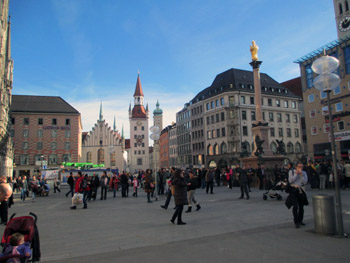
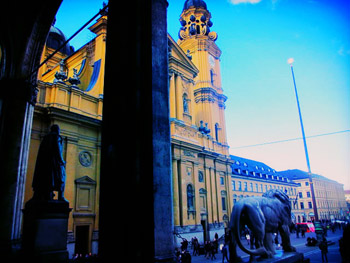 Instead of carrying around a thick guide book which forces visitors to stare down at the tiny print and flip pages, a great option for those seeking to learn about the war-related history is to sign up for Sandeman’s New Europe, Third Reich walking tour. For 12 euro, my journey through the dark history began at the center of the city, at the beautiful Marienplatz. Immediately, the tour guide, who was a walking treasure chest of knowledge instructed the group of 10-15 people to look up at our surroundings. After explaining how the majority of the area was completely bombed out during World War II, he pointed to the main spires of the Marienplatz, and the giant green domes from the Frauenkirche. He explained how the bomber jets from the allied forces used them as landmarks in their bombing campaign, therefore they were spared and remained mostly intact. Chills immediately shot down my spine, as I felt the realness in which surrounded me. This was real, and these were not events which took place in the Dark Ages; this was a time that our close relatives could have lived through. It was a time in which the desperation of the German people gave way to the rise of a former painter from Austria, and allowed Adolf Hitler to guide his people, and the world into a conflict that took the lives of nearly 85 million people.
Instead of carrying around a thick guide book which forces visitors to stare down at the tiny print and flip pages, a great option for those seeking to learn about the war-related history is to sign up for Sandeman’s New Europe, Third Reich walking tour. For 12 euro, my journey through the dark history began at the center of the city, at the beautiful Marienplatz. Immediately, the tour guide, who was a walking treasure chest of knowledge instructed the group of 10-15 people to look up at our surroundings. After explaining how the majority of the area was completely bombed out during World War II, he pointed to the main spires of the Marienplatz, and the giant green domes from the Frauenkirche. He explained how the bomber jets from the allied forces used them as landmarks in their bombing campaign, therefore they were spared and remained mostly intact. Chills immediately shot down my spine, as I felt the realness in which surrounded me. This was real, and these were not events which took place in the Dark Ages; this was a time that our close relatives could have lived through. It was a time in which the desperation of the German people gave way to the rise of a former painter from Austria, and allowed Adolf Hitler to guide his people, and the world into a conflict that took the lives of nearly 85 million people.
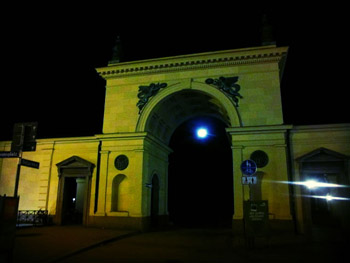 Walking through the streets of the 1,000-year-old city would lead most to believe that the surrounding buildings go back hundreds of years, but they would be greatly mistaken. Following the rise of Adolf Hitler in the early 1930s, Munich became the birthplace of the Nazi Party, and eventually one of the biggest targets for the allies during World War II. The result was thousands of bombs being droppedtact on the city, and to this day, an estimated 2,000 un-detonated bombs are still buried beneath the city. Since nearly 90 percent of the city was completely demolished, everything has been rebuilt, and reconstructed in the 70 years since to end of the war. While construction continues in the Bavarian capital, bombs are still discovered on a weekly basis, and teams have to come in to safely detonate the bombs which range anywhere from 4 lbs to 22,000 lbs. Our tour guide told stories how entire street blocks have to be closed, and entire apartment complexes cleared out when one is discovered. Life goes on, and the residents of Munich accept it as if it is nothing more than a minor inconvenience.
Walking through the streets of the 1,000-year-old city would lead most to believe that the surrounding buildings go back hundreds of years, but they would be greatly mistaken. Following the rise of Adolf Hitler in the early 1930s, Munich became the birthplace of the Nazi Party, and eventually one of the biggest targets for the allies during World War II. The result was thousands of bombs being droppedtact on the city, and to this day, an estimated 2,000 un-detonated bombs are still buried beneath the city. Since nearly 90 percent of the city was completely demolished, everything has been rebuilt, and reconstructed in the 70 years since to end of the war. While construction continues in the Bavarian capital, bombs are still discovered on a weekly basis, and teams have to come in to safely detonate the bombs which range anywhere from 4 lbs to 22,000 lbs. Our tour guide told stories how entire street blocks have to be closed, and entire apartment complexes cleared out when one is discovered. Life goes on, and the residents of Munich accept it as if it is nothing more than a minor inconvenience. Prior to the air-raids by allied troops, Adolf Hitler was well aware that Munich would be a major target, and knew the city would be leveled. Planning ahead, he ordered photos be taken throughout the city, so that when the war ended, the city could be built exactly as it was prior to its near destruction. Following the death of Hitler and the fall of the Nazi’s, the German people voted to restore the city to its old glory, resulting in a complete rebuild. Since everything has been rebuilt, it gives visitors a unique perspective roaming the streets, and ducking into beer halls and cafes that fill the city. While the history is thick, and I could nearly feel it hanging in the air, it also felt like stepping into a movie set. Along the guided tour, we were taken to places of historical significance, such as the world-famous Hofbräuhaus. We were taken upstairs into the beautiful beer hall, and shown the place where the Nazi leader once spoke. However, the reality is that the building is a complete replication of the original, somewhat taking away some of the powerfulness which stood before me. It is fascinating, yet saddening how such beautiful architecture and sights were destroyed, but in spite of the restoration, there is still the ghost of the German dictator that echoes throughout the halls.
Prior to the air-raids by allied troops, Adolf Hitler was well aware that Munich would be a major target, and knew the city would be leveled. Planning ahead, he ordered photos be taken throughout the city, so that when the war ended, the city could be built exactly as it was prior to its near destruction. Following the death of Hitler and the fall of the Nazi’s, the German people voted to restore the city to its old glory, resulting in a complete rebuild. Since everything has been rebuilt, it gives visitors a unique perspective roaming the streets, and ducking into beer halls and cafes that fill the city. While the history is thick, and I could nearly feel it hanging in the air, it also felt like stepping into a movie set. Along the guided tour, we were taken to places of historical significance, such as the world-famous Hofbräuhaus. We were taken upstairs into the beautiful beer hall, and shown the place where the Nazi leader once spoke. However, the reality is that the building is a complete replication of the original, somewhat taking away some of the powerfulness which stood before me. It is fascinating, yet saddening how such beautiful architecture and sights were destroyed, but in spite of the restoration, there is still the ghost of the German dictator that echoes throughout the halls.